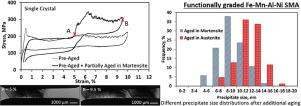当前位置:
X-MOL 学术
›
Scr. Mater.
›
论文详情
Our official English website, www.x-mol.net, welcomes your feedback! (Note: you will need to create a separate account there.)
Functionally graded structures realized based on Fe–Mn–Al–Ni shape memory alloys
Scripta Materialia ( IF 6 ) Pub Date : 2021-03-01 , DOI: 10.1016/j.scriptamat.2020.10.057 M. Vollmer , A. Bauer , M.J. Kriegel , M. Motylenko , T. Niendorf
Scripta Materialia ( IF 6 ) Pub Date : 2021-03-01 , DOI: 10.1016/j.scriptamat.2020.10.057 M. Vollmer , A. Bauer , M.J. Kriegel , M. Motylenko , T. Niendorf

|
Abstract In the present study a novel approach to obtain functionally graded properties in an Fe–Mn–Al–Ni shape memory alloy is introduced. A single crystalline sample showing superelastic properties was aged in a partially martensitic state. As a result, the area aged in austenite is characterized by a changed superelastic hysteresis with different critical stresses for forward and backward transformation, whereas the properties in the area aged in martensite remained almost unchanged. Transmission electron microscopy studies revealed that the mean average size of nanometric β precipitates, which strongly influence the transformation temperatures and eventually the transformation stresses, is about 9 nm in the area aged in martensite and about 12 nm in the area aged in austenite. Based on these results it seems to be feasible to tailor Fe–Mn–Al–Ni components in a way allowing them to show locally different functional properties.
中文翻译:

基于 Fe-Mn-Al-Ni 形状记忆合金实现的功能梯度结构
摘要 在本研究中,介绍了一种在 Fe-Mn-Al-Ni 形状记忆合金中获得功能梯度性能的新方法。显示超弹性性能的单晶样品在部分马氏体状态下进行时效。因此,奥氏体时效区域的特征是超弹性滞后发生变化,向前和向后转变的临界应力不同,而马氏体时效区域的特性几乎保持不变。透射电子显微镜研究表明,对转变温度和最终转变应力产生强烈影响的纳米 β 析出物的平均平均尺寸在马氏体时效区域约为 9 nm,在奥氏体时效区域约为 12 nm。
更新日期:2021-03-01
中文翻译:

基于 Fe-Mn-Al-Ni 形状记忆合金实现的功能梯度结构
摘要 在本研究中,介绍了一种在 Fe-Mn-Al-Ni 形状记忆合金中获得功能梯度性能的新方法。显示超弹性性能的单晶样品在部分马氏体状态下进行时效。因此,奥氏体时效区域的特征是超弹性滞后发生变化,向前和向后转变的临界应力不同,而马氏体时效区域的特性几乎保持不变。透射电子显微镜研究表明,对转变温度和最终转变应力产生强烈影响的纳米 β 析出物的平均平均尺寸在马氏体时效区域约为 9 nm,在奥氏体时效区域约为 12 nm。

























 京公网安备 11010802027423号
京公网安备 11010802027423号